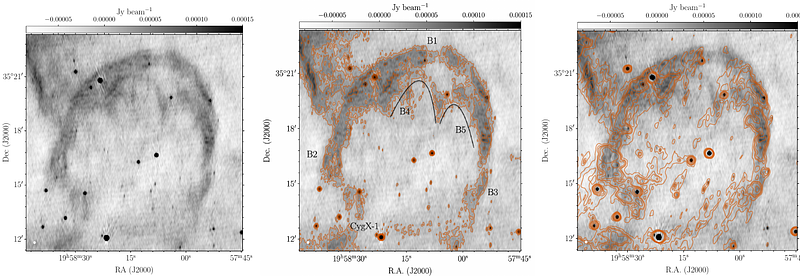Quantifying jet-interstellar medium interactions in Cyg X-1: Insights from dual-frequency bow shock detection with MeerKAT

Quantifying jet-interstellar medium interactions in Cyg X-1: Insights from dual-frequency bow shock detection with MeerKAT
P. Atri, S. E. Motta, Jakob van den Eijnden, James H. Matthews, James C. A. Miller-Jones, Rob Fender, David Williams-Baldwin, Ian Heywood, Patrick Woudt
AbstractAccretion and outflows are astrophysical phenomena observed across a wide range of objects, from white dwarfs to supermassive black holes. Developing a complete picture of these processes requires complementary studies across this full spectrum of jet-launching sources. Jet-interstellar medium (ISM) interaction sites near black hole X-ray binaries provide unique laboratories to study jet energetics. This work aims to detect and characterise the bow shock near one black hole X-ray binary, Cyg X-1, and then use this bow shock structure to parametrise the properties of the jet launched by Cyg X-1 over its lifetime. We used the MeerKAT radio telescope to investigate the bow shock structure formed by the interaction between the jets of Cyg X-1 and the ISM. We successfully detect the bow shock north of Cyg X-1 in the L and S bands and report its size and brightness. We present the spectral index distribution across the bow shock, which is in the range -0.9 to 0.4, with an error distribution (0.6 to 1.5) that peaks at unity. We determine that the unshocked ISM density is 6-7 cm^-3 for a temperature range of 10^4 to 3*10^6 K. This temperature range suggests that the velocity of the bow shock is 21 km/s to 364 km/s. The age of the Cyg X-1 jet responsible for the bow shock is 0.04 to 0.3 Myr, and the power of the jet is constrained to 2*10^31 ergs/s to 10^35 ergs/s. We also detect new morphological features of the bow shock in the S-band image. The comparison of archival H_alpha maps with the new radio observations hints at different regions of emission, different temperature ranges, and different ISM densities. The spectral index suggests a consistent emission origin across the structure. The ISM density around Cyg X-1 is on the higher end for Galactic environments, and our results indicate a lower jet energy transport rate than prior estimates.